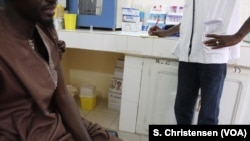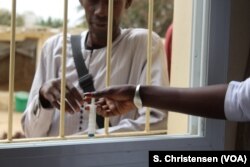Following a trend among industrialized nations, hard drugs are now making their way into the hands of West African consumers. With European markets saturated, experts believe drug barons are increasingly turning their attention to the region. That has led to an increase in addicts, and the opening of West Africa's first drug rehabilitation center.
The first time Omar took heroin was in France during the 1980s.
As a young Senegalese student in Paris, he was lured to the back alleys of the Rue de Flandres and Gare de Lyon, notorious hotbeds for drugs at the time.
Now in his late fifties, Omar, who did not wish to use his real name, said heroin and cocaine are creeping into Senegal’s drug scene.
“I discovered heroin in the West,” said Omar. “But users in their twenties discovered it here.”
Experts say drug consumption in West and Central Africa is on the rise.
Cannabis is by far the most widespread substance, but hard drugs are becoming more prevalent. The United Nations Office on Drugs and Crime's most recent estimates for West and Central Africa amount to 1.8 million cocaine users in 2016 and around 1 million heroin users in 2015.
Pierre Lapaque, the UNODC’s regional representative, said Senegal is a natural transit point for traffickers smuggling drugs to Europe from Latin America.
"They used to give their accomplices cash," he said, "but now they are paid in produce."
Lapaque believes drug lords are purposely dumping products in the region so that local dealers can charge a price low enough to attract consumers and create a new market.
Research done by this reporter on the streets shows that one gram of pure cocaine can be purchased for as little as $35, compared to $90 in France. A rock of crack costs less than $10.
“Drug users are typically male, aged less than 25 and from a middle- or lower-middle-class background,” said Lapaque. “This profile fits perfectly with Africa’s emerging population.”
In Dakar’s addiction center, nurses weigh patients and take blood samples.
Launched in 2015, it is West Africa’s first drug rehabilitation facility and the region's only methadone administrator. Treatment for heroin addicts, who come to the center every morning for a dose of the medication, is subsidized by the state.
Senegal’s government took action after a 2011 study found Dakar had more than 1,300 injectable drug users, with an HIV infection rate of more than 9 percent.
The center’s director, Idrissa Ba, said he received more than 2,000 patients over the past three years, about a quarter of whom were heroin addicts.
“The profile of patients has diversified,” said Ba. “We are seeing more young people, and even a small number of women."
Outside Ba’s office, methadone patients smoke cigarettes as they rest in the shade.
A 42-year-old man who told his story said addicts rarely keep to a single type of drug.
“Almost everyone smokes cannabis here,” he said. “And people [who] take methadone continue to smoke crack.”
This year, Senegal’s main public university started a course for health workers to identify and respond to different forms of drug addiction.
Doctor Adama Koundoul heads a psychiatric center in Ziguinchor, the capital of Senegal’s southern Casamance region. He observed an increase in the use of hard drugs among his patients, and traveled to Dakar for training.
Koundoul blames lack of regulation and the constant movement of people.
“Zinguinchor is at a crossroad between Gambia, Guinea and Guinea-Bissau. And it is also a major tourist destination,” he said.
Experts and health officials agree that Senegal should do more to crack down on the drug trade.
In 2007, Senegal’s national anti-drug trafficking body seized a record 1.2 tons of cocaine near the beach town of Nianing, an area populated with holiday resorts.
Smaller quantities are regularly intercepted at the border and destroyed by the authorities.
But as new drugs infiltrate the local market, a new battle begins.









